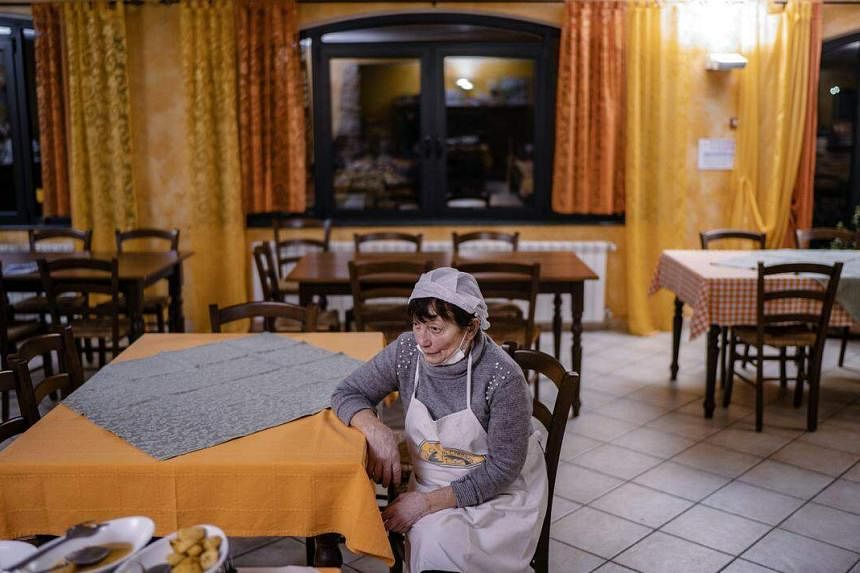LIVEMMO, Italy – The only full-time employee of Livemmo, a secluded mountain village of 196 residents in northern Italy, has a lot on his to-do list.
At 7.26am one day, he stamped his time card, lifted the blinds and straightened up the town hall office.
He drove the yellow school bus over fog-shrouded roads, picking up little children in winter hats from surrounding hamlets, beeping at the curves slick with red autumn leaves and taking it slow around the bell towers.
Back in the office, he paid a bill and answered e-mail. Then he turned to his other task: helping the village spend nearly €20 million (S$28.5 million) earmarked by Italy to save Livemmo from oblivion.
“It’s a huge job to spend all this money,” said Mr Marino Zanolini, 57, of the bounty. “At the end, if something goes wrong, you know whose fault it will be.”
In 2022, Livemmo beat dozens of other villages in the Lombardy region for a share of about €200 billion in Covid-19 recovery funds set aside for Italy by the European Union.
The country has one of the oldest populations in Europe, and the combination of its paltry birth rate and the increased longevity of its booming population of older people has created an economic and existential crisis that has vexed successive governments.
Italy has allocated €420 million in relief funds to reverse the ageing and vanishing of 21 of its most threatened small villages – one in each major region or province.
Livemmo, known for its mountain walks, cow pastures and carnival parade featuring characters such as a woman holding a man in a basket, won its region’s reinvigoration lotto with a proposal to evolve into a vibrant tourist destination.
Its pitch included spending for decent Wi-Fi (€366,000), expanded tourist lodgings in its centuries-old stone homes (€549,000) and a network of expanded bike paths (€5.86 million).
It plans to convert a dirt field surrounded by yellow and blue plastic seats nailed into logs into a new sports complex with synthetic turf, parking and locker rooms (€1.22 million). It foresees the purchase of private warehouses to be converted into centres for local cheese, honey and woodworking artisans (€3.03 million).
To make up for the loss of its lone doctor, who retired in November, it has also proposed telemedicine bracelets that monitor the vitals of the village’s ageing residents (€183,000). It has budgeted incentives to draw more families, businesses and “creative start-ups in the sector of contemporary art, with particular focus on the theme of wood” (€1.46 million).
“It’s a unique, once-in-a-lifetime and unimaginable opportunity,” said Mr Giovanmaria Flocchini, mayor of the town that includes the village of Livemmo.
He considered the village not only part of a critical experiment for Italy, but also for ageing societies across Europe, to prove that an influx of cash can save towns – and all of their cultural heritage and history – from depopulation and abandonment. “I feel doubly responsible,” he said. “If it fails for us, it fails for everybody.”
But the village needs to start spending the money no later than July and finish by June 2026.
Mr Zanolini, who has been working for Livemmo for nearly 30 years and likes to take lunch breaks at his parents’ house down the road, is worried about the tens of thousands of documents in the planning phase and then the tens of thousands more contracts to organise, digitally sign and pay out in the payment phase.
“Everything has to go through the town hall,” he said. “Ninety per cent of the time, I’m alone.”

Mr Flocchini, who is also the president of a local association of administrators who helped draft the proposal, is negotiating with the regional and national governments to let him use €800,000 of the funds over four years to hire professional consultants.
In a part of the country with high employment, he is finding it difficult to lure locals away from solid jobs more than 30km away for temporary jobs closer to home.
After a brief walk around the village, of the warehouses he envisioned as cultural centres and the 17th-century stone homes he imagined as charming tourist lodgings, the mayor returned to the town hall and watched Mr Zanolini show a resident how to snap on the lid of her new garbage pail so that it would not break in the cold.
The mayor admired the town’s employee as a jack of all trades, but said, “he can’t do this, it is not his job”.
As is the case with many small towns across Italy, he added: “I don’t deny that we’re having a tough time managing this.”
The deeper challenge, though, may be that a significant and senescent portion of the population does not want the money.

“My fear is that the whole town will be changed. We’ll be invaded by people we don’t know,” said Ms Graziella Scuri, 73, owner of one of Livemmo’s five restaurants, as she spooned out housemade casoncelli pasta doused in butter. She added that a defining character trait of the hard-working and often isolated locals was “we’re a little closed”.
Partly out of necessity, Mr Flocchini has pinned his hopes on Livemmo’s young, and families in particular, confident that some of them might buy the restaurants from ageing owners or start businesses and have more children to keep the local school afloat.

Ms Giulia Turrini, 33, who has two young children, operates a bed and breakfast in the historic town hall building.
The village hopes to turn the stone cellar, now filled with scrap metal, petrol tanks and broken doors and baskets, into a showroom for local wines and cheeses.
“The people my age will get the most out of this,” she said of the government money. “The older generation is more negative. They fear change.” NYTIMES

